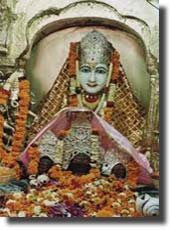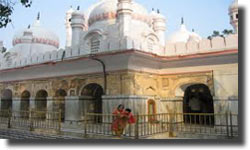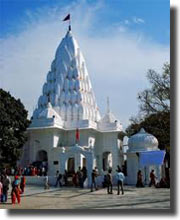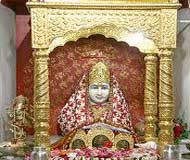Location :
Adjoining to the Mansa Devi mandir, there is a beautiful garden consisting of sacred plants. People come from all over the world to pay homage to the goddess. During Navratri, fairs take place in the surrounding areas of Mansa Devi temple.
History of the Temple
In the year 1840 at a distance of 200 meters from the main temple is the Patiala temple which was got constructed by Sh. Karam Singh, the then Maharaja of Patiala.
This temple had the patronage of Manimajra State. After the merger of princely states into Pepsu, the Patronage of State Govt. ended and the temples remained neglected. The Raja of Manimajra then appointed pujari as ‘khidmatuzar' of this temple whose duty was to worship the deity of the temple.
Mansa Devi temple is located in Bilaspur village, which is around three kilometers to the east of Mani Manjra, adjoining Chandigarh. The temple is thronged by hundreds of devotees from all over the country and even tourists from abroad, during Navratri. The temple is dedicated to Goddess Mansa. People believe that the deity is very powerful and fulfills every wish of the devotees.
Maa Parvati insisted that she may be told the immortal secret and for long Shiva ji continued postponing. Finally one fine day because of constant demand of Maa Parvati, Lord Shiva made up his mind to tell the immortal secret. He started revealing the story in a lonely place where no living being could listen it for he choose Amarnath Cave.
Archaeologists and historicists have immense interest to visit the Mansa Devi Temple, when they are touring through Chandigarh due to the legacy of the temple. The walls of the temple are beautifully adorned with paintings of shrines. This particular architectural beauty of the temple comes from Shivalik background as well. History gives the evidences that the temple was constructed in the Panchayantana pattern and serves as must-visit excursion of Chandigarh.
Who build the Temple

The temple is at a distance of 200 meters from the main temple is the Patiala temple which was constructed by Karam Singh initially, then a Sikh, the then Maharaja Patiala in the year 1840. This temple had the patronage of Manimajra State.
Significance of the temple
There are two temples located in the complex of Mansa Devi. The main temple is dedicated to Mansa who is worshipped in the sanctum sanctorum both in the form of ‘pindi' as well as in her anthropomorphic form executed on a marble. In the sanctorum the devi is worshipped with Devi Saraswati and Lakshmi in the form of Pindi (Stone pebbles). Originally the pindis were only worshipped by the devotees. However, in modern times a marble bust of the deity was got sculpted for giving an attractive human look (form) to the deity.

All the five temples in the complex show four minarets at four corners with a cupola on its top. The domes are onion shaped and stand on an elongated circulator drum. The facade of the temple shows miniature vaulted alcoves.
In the sanctorum, the Mansa Devi in Chandigarh is worshipped in its anthropomorphic form sculpted on marble. The bust is enshrined in a silver plated small vaulted shrine showing a beautiful decoration of silver embossing works throughout the body of the miniature vaulted shrine. Here also the pindi (stone) is worshipped along with the marble bust.
The architecture of the main temple has mughal features but this temple has a covered 'Parikarma', which is a salient feature of Hindu art and architecture.
Time to visit
Navratri festival is the best time to visit where the fest is celebrated in the mandir for nine days. Twice in a year millions of devotees visit the Mansa Devi Temple. Druing Chaitra and Ashvin months Shardiya Navratra mela are organized at the shrine complex. Every year two Navratra melas are organised in the month of Shardiya, Sharad or Winter Navratra and the other one in the month of Chaitra, Spring Navratra by the Shrine Board.
Mansa Devi temple remains open from 4-00 A.M. to 10-00 P.M. in the summer and from 5-00 A.M. to 9-00 P.M. in the winter. From the main gate every body can have Darshan during this period. The Red Stone Pavement of size 75'X105' in from of Shakti Dhwaj where devotees wait for their turn. There is a Brass railing from Shakti Dhwaj to Ardh Mandap which has been laid so that devotees may enter the temple in two queues and have easy Darshan without any difficulty of rush. The devotees are allowed to bring packed prashad in the mandir. The prashad so offered by the devotees is placed in the feet of the deity and returned to the devotees. Offering in kind is poured in the Dan Pater placed in front of each temple.
Accommodation Facilities at the Temple
The Mansa Devi shrine has one Dharamshala consisting of 30 rooms and one hall which are available to the pilgrims free of any charge. Blankets are also provided free of charge. The Board has constructed another Dharamshala called Lajwanti Dharamshala consisting of 15 rooms. These rooms are having modern facilities such as attached toilets where in geysers have been provided and the rooms are air cooled Each room has been provided with double bed with mattresses pillows, bed sheets and blankets, one table, two chairs and one almirah.
For the proper upkeep of this Dharamshala a nominal charge of Rs. 200/- per day is charged.
| The Haryana Tourism Corporation has also constructed a Yatrika "called Jatayu" which is at the distance of 50 yards from the Temple which provides dormitory type accommodation and facilities of restaurant to the pilgrims. Each room has been provided with attached toilet and each room has four beds. | Nearby tourist places to Mansadevi Temple
Chail Chandigarh Haridwar Shimla |
 |
How to reach the Temple
- By Bus - The Temple is located at a distance of about 10 km from the Chandigarh bus terminus and 4 km from the Panchkula bus terminus, the Mansa Devi temple can be reached by local buses or autorickshaws. The Chandigarh Transport Undertaking and even the Haryana Roadways have special buses during the Navratra fair.
- By Air - Nearest Airport is Chandigarh. There are daily flights operated by Indian Airlines and private airlines to Chandigarh. Since it's a popular travel circuit, bookings ought to be made well in advance.
- By Rail - Chandigarh is the ideal place to start off if you intend to visit the temple. If you are travelling by train, Chandigarh is the nearest railhead for those heading to Mata Mansa Devi temple. It is situated on the Chandigarh- Kalka rail line.



